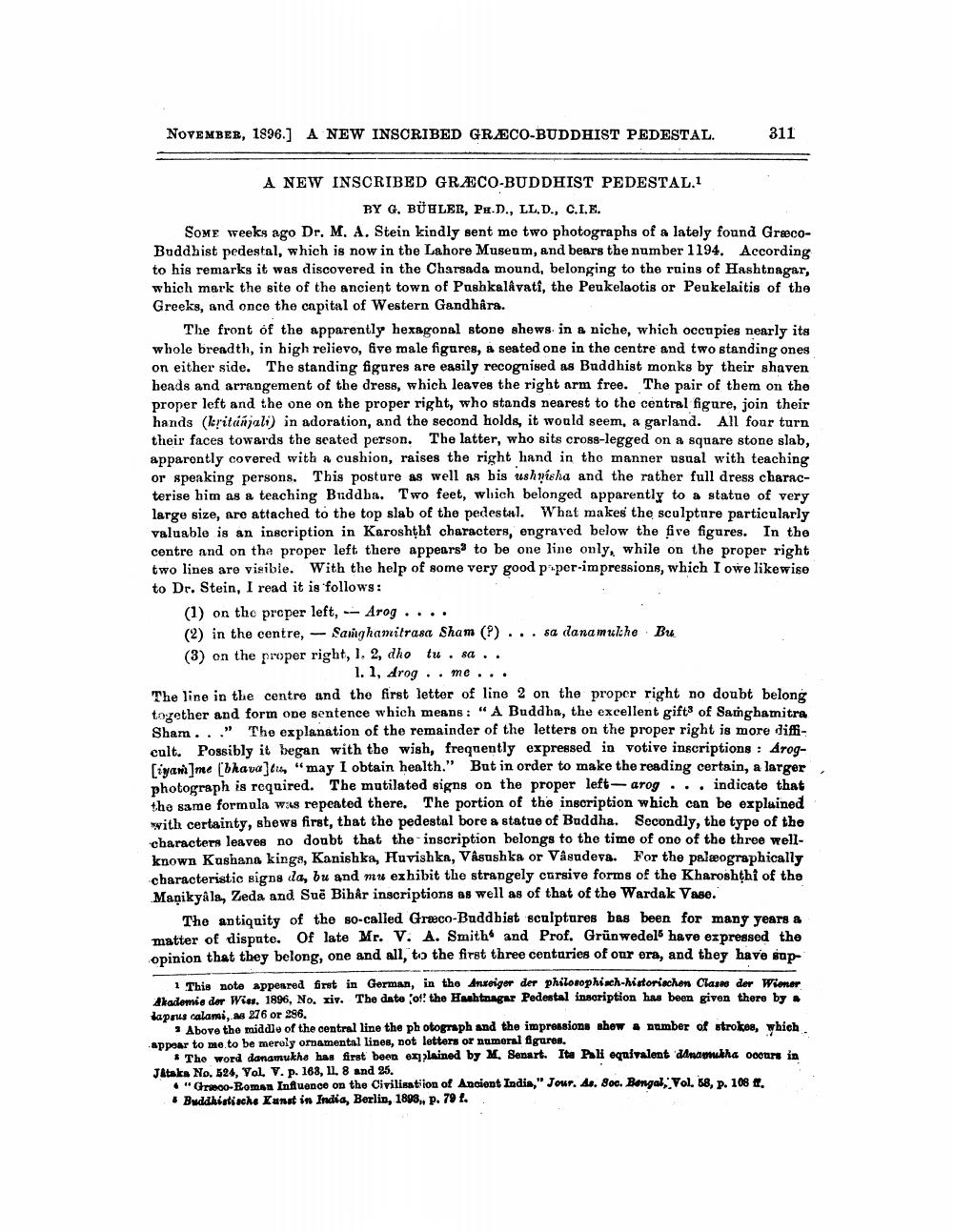________________
NOVEMBER, 1896.] A NEW INSCRIBED GRÆCO-BUDDHIST PEDESTAL.
311
A NEW INSCRIBED GRÆCO-BUDDHIST PEDESTAL.
BY G. BÜHLER, PH.D., LL.D., C.I.E. SOME weeks ago Dr. M. A. Stein kindly sent me two photographs of a lately found GræcoBuddhist pedestal, which is now in the Lahore Museum, and bears the number 1194. According to his remarks it was discovered in the Charsada mound, belonging to the ruins of Hashtnagar, which mark the site of the ancient town of Pashkalâvati, the Peukelaotis or Peukelaitis of the Greeks, and once the capital of Western Gandhira.
The front of the apparently hexagonal stone shews in a niche, which occupies nearly its whole breadth, in high relievo, five male figures, a seated one in the centre and two standing ones on either side. The standing figures are easily recognised as Buddhist monks by their shaven heads and arrangement of the dress, which leaves the right arm free. The pair of them on the proper left and the one on the proper right, who stands nearest to the central figure, join their hands (leritrinjali) in adoration, and the second holds, it would seem, a garland. All four turn their faces towards the seated person. The latter, who sits cross-legged on a square stone slab, apparontly covered with a cushion, raises the right hand in the manner usual with teaching or speaking persons. This posture as well as bis ushnisha and the rather full dress characterise him as a teaching Buddba. Two feet, which belonged apparently to a statue of very large size, are attached to the top slab of the pedestal. What makes the sculpture particularly valuable is an inscription in Karoshtht characters, engraved below the fire figures. In the centre and on the proper left there appears to be one line only, while on the proper right two lines are visible. With the help of some very good paper-impressions, which I owe likewise to Dr. Stein, I read it is follows:
(1) on the proper left, --- Arog.... (2) in the centre, - Sanghamitrasa Sham (P) ... sa danamuelche Bu (3) on the proper right, I. 2, dho tu . sa ..
1. 1, drog..me ... The line in the centre and the first letter of line 2 on the proper right no doubt belong together and form one sentence which means: "A Buddha, the excellent gift of Sanghamitra Sham..." The explanation of the remainder of the letters on the proper right is more difficult. Possibly it began with the wish, frequently expressed in votive inscriptions : Arog[iyan]me (bhava]"may I obtain health." But in order to make the reading certain, a larger photograph is required. The mutilated signs on the proper left-arog ... indicate that the same formula wis repeated there. The portion of the inscription which can be explained with certainty, shews first, that the pedestal bore a statue of Buddha. Secondly, the type of the characters leaves no doubt that the inscription belongs to the time of one of the three wellknown Kushana kinga, Kanishka, Huvishka, VÅsushka or Vasudeva. For the palæographically characteristic signs da, bu and mu exhibit the strangely cursive forms of the Kharoshtht of the Manikyala, Zeda and Sue Bihår inscriptions as well as of that of the Wardak Vase.
The antiquity of the so-called Græco-Buddbist sculptures bas been for many years a matter of dispute. Of late Mr. V. A. Smith and Prof. Grünwedel have expressed the opinion that they belong, one and all, to the first three centuries of our era, and they have sup
Thio noto appeared first in German, in the Anweiger der philosophisch-historischen Classe der Wiener Akademie der Wien. 1896, No. xiv. The date of the Hashnagar Pedestal inscription has been given there by laprus calani, as 276 or 286.
Above the middle of the central line the photograph and the impressions show a number of strokes, which appear to me to be merely ornamental lines, not letters or numeral figures.
The word danamukha has first been explained by M. Senart. Ita Pali equivalent danaowkha ooonrs in Jätaks No. 524, Vol. V. p. 168, 11. 8 and 25.
"Groo-Roman Influence on the Civilisation of Ancient India," Jour. 4. Soc. Bengal, Vol. 58, p. 108 8. Buddhistische Kunst in India, Berlin, 1898, p. 79 f.




